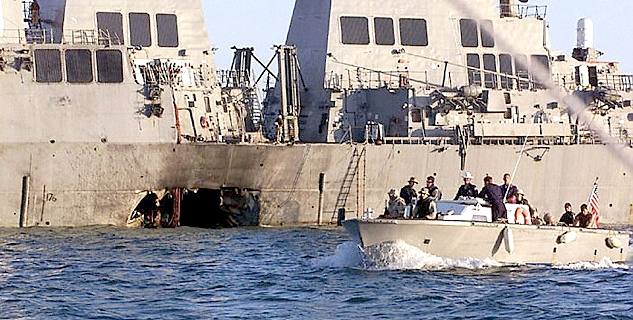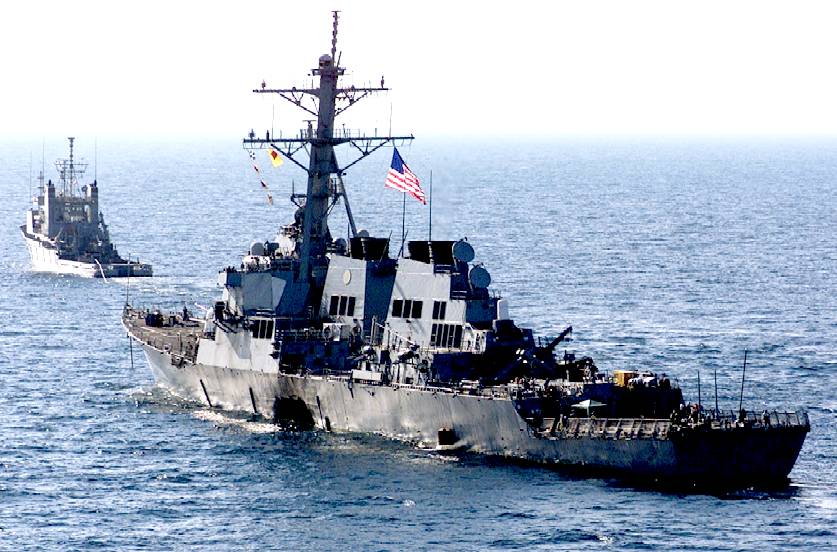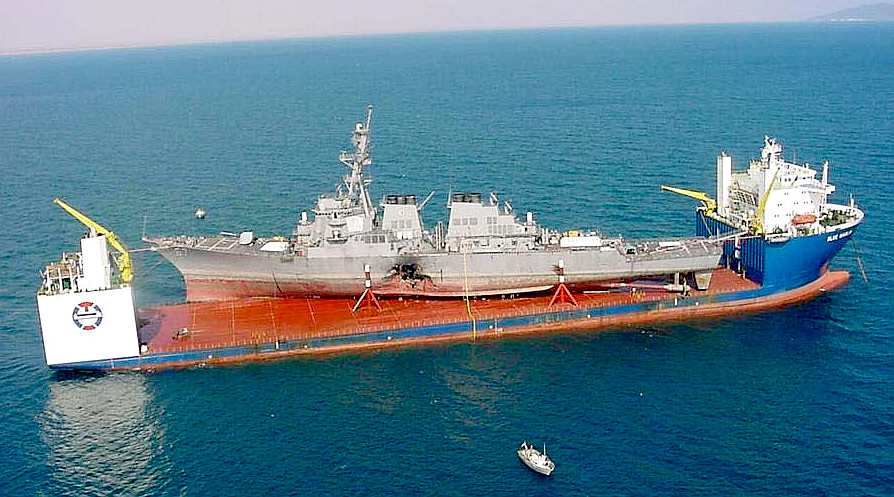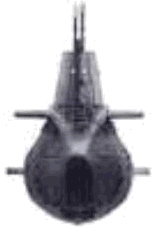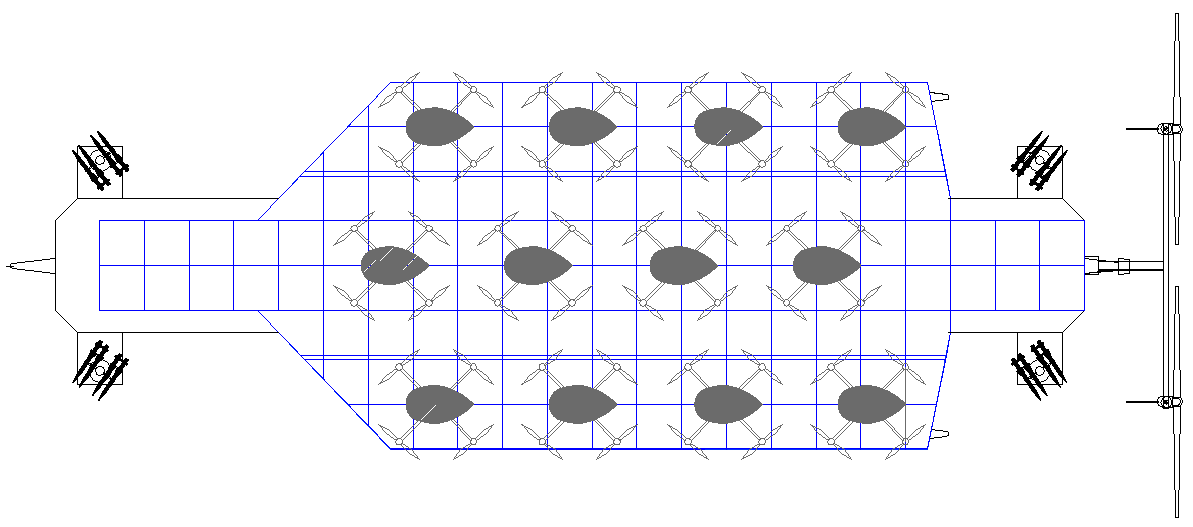|
US NAVY - AUTONOMOUS SWARM DRONES
|
||
|
The portside damage to the guided missile destroyer USS Cole is pictured after a bomb attack during a refueling operation in the port of Aden, Yemen, October 12, 2000.
Reminiscent of the underwater chariots and frogmen attacks of World War II, the attack on the USS Cole demonstrates just how vulnerable a large warship is, once their Achilles heel is identified.
With the world in a 'drone' technology race, it won't be long before Al-Qaeda cotton to the fact that robots are potentially the equalizer that they are looking for.
SWARM BOATS COULD HAVE PREVENTED ATTACK ON USS COLE RESEARCHERS SAY
RESCUE - After the attack the USS Cole was assisted by a number of ships
USS COLE
USS Cole (DDG-67) is an Arleigh Burke-class Aegis-equipped guided
missile destroyer
home-ported in Naval Station Norfolk, Virginia. Cole is named in honor of Marine Sergeant Darrell S. Cole, a machine-gunner killed in action on Iwo Jima on 19 February 1945, during
World War II. Cole is one of 62 authorized Arleigh Burke-class guided missile destroyers, and one of 21 members of the Flight I-class that utilized the 5"/54 caliber gun mounts found on the earliest of the Arleigh Burke-class destroyers. The ship was built by Ingalls
Shipbuilding and was delivered to the
US Navy on 11 March 1996.
AL-QAEDA ATTACK
On the morning of Thursday, 12 October 2000, USS Cole, under the command of Commander Kirk Lippold, docked in Aden harbor for a routine fuel stop. Cole completed mooring at 09:30; refueling started at 10:30. Around 11:18 local time (08:18 UTC), a small craft approached the port side of the destroyer, and an explosion occurred afterward, creating a 40-by-60-foot gash in the ship's port side, according to the memorial plate to those who lost their lives. According to former
CIA intelligence officer Robert Finke, the blast appeared to be caused by explosives molded into a shaped charge against the hull of the boat. Around 400 to 700 pounds (200–300 kg) of explosive were used. The blast hit the ship's galley, where crew were lining up for lunch. The crew fought flooding in the engineering spaces and had the damage under control after three days.
Divers inspected the hull and determined that the keel was not damaged.
RULES OF ENGAGEMENT
The destroyer's rules of engagement, as approved by the
Pentagon, kept its guards from firing upon the small boat (which was not known to be loaded with explosives) as it neared them without first obtaining permission from the Cole's captain or another officer.
This incident has changed the way that the Pentagon and other Governments view the rules of engagement, prompting the "swarm drones". A credible threat such as an unidentified small vessel approaching a warship, may now be treated as hostile - without any shots fired. In our opinion as military strategists, this should not be limited to harbour situations, but extend to blue waters.
The fact that small boats always were treated with suspicion and could not be neutralized at an early stage is interesting. Modern sensing and behavioral analysis algorithms (such as used to identify pirates) might be used to ward of potential risks before they become serious, for which a network of persistent drones at sea is a valuable fleet insurance that the navies of the world may want to investigate.
USS
STARK, IRAN-IRAQ WAR & EXOCET MISSILES
DRONE
SUBS -
A submarine might get lucky and evade the HK, wolf pack, but once the position of a submarine is known and transmitted, it will never be safe and from then on the drone HKs will converge upon it. The mission of drone HKs is to find enemy submarines: persistently. The secondary objective of drone HKs is to sink destroyers and aerial drones that may be sent out to hunt them.
COST EFFECTIVENESS - By a process of attrition, drone HKs will decimate an enemy fleet and financially frustrate any state, even a super power. The maths is simple. A drone HK cost only a few $million with no loss of life, compared to a manned destroyer which costs a small fortune and kills hundreds of crew. The traditional investment in huge floating iron coffins becomes wasted capital.
UNMANNED SUBMARINES - The logical conclusion is to eliminate the crew from submarines and bring in countermeasures. The technology exists to enable this, but submarines, either manned or unmanned will need to be supported by friendly surface drones where aerial and marine drones like that shown could make their situation untenable. Thus, the main reason for maintaining a fleet of nuclear submarines, namely to be able to launch a nuclear strike, is neutralized. Contact BMS to find out more.
Much of the discussion and fear of armed unmanned vehicles ignores a central fact. Aerial drones like the Predator or Reaper are operated by two-man human teams, a pilot to steer the drone, and a sensor operator to control the various mechanical eyes and ears. The boats that participated in the event on the James River were able to sense one another as well as other vessels, and execute complicated “swarm” maneuvers, with a bare minimum of guidance. These boats are not your average drones.
LINKS & REFERENCE
Extreme Tech US-navy-deploys-autonomous-unmanned-swarmboats-to-keep-its-larger-ships-safe The Guardian 2014 Oct 5 US Navy unmanned drone swarm boats Wired Navy-self-driving-swarmboats IB Times autonomous-us-navy-swarm-boats-could-have-prevented-attack-uss-cole-researchers-say EV world submarine drone launch Spectrum IEEE military robots navy launches drone from submarine MOD Contracts Intellectual Property - defending and commercialising ideas http://www.army.mil/ http://en.wikipedia.org/wiki/USS_Cole_bombing http://en.wikipedia.org/wiki/USS_Cole_%28DDG-67%29 http://www.theguardian.com/us-news/2014/oct/05/us-navy-unmanned-drone-boats http://www.lockheedmartin.com/ http://www.lockheedmartin.co.uk/ http://www.ipo.gov.uk/types/patent/p-os/p-find/p-ipsum/Case/PublicationNumber/GB2511731
Arleigh Burke-class Aegis-equipped guided missile destroyer
WORLD FIRST - An HK-ZCC class autonomous aircraft carrier / destroyer, showing deployment of a squadron of 12 fighter quadcopter drones. To overcome the potential for communications jamming, in a cyber-warfare situation, the battleship and the quadcopter squadron would be able to operate independently to target and neutralize incoming threats - or indeed, carry out operational attacks. There are no rules in war when dealing with an aggressor who themselves have no rules. Civilised military go all out to safeguard humans from unnecessary suffering. It's a two stage response situation, where, if an enemy breaks the rules of humane engagement, the gloves are off.
|
||
|
This website is Copyright © 2015 Bluebird Marine Systems Ltd. The names Bluebird™, Bluefish™, SeaNet™, and the blue bird and fish in flight logos are trademarks. CONTACTS The color blue is a protected feature of the trademarks.
|

